tabernacle prayer guide
- by stephany
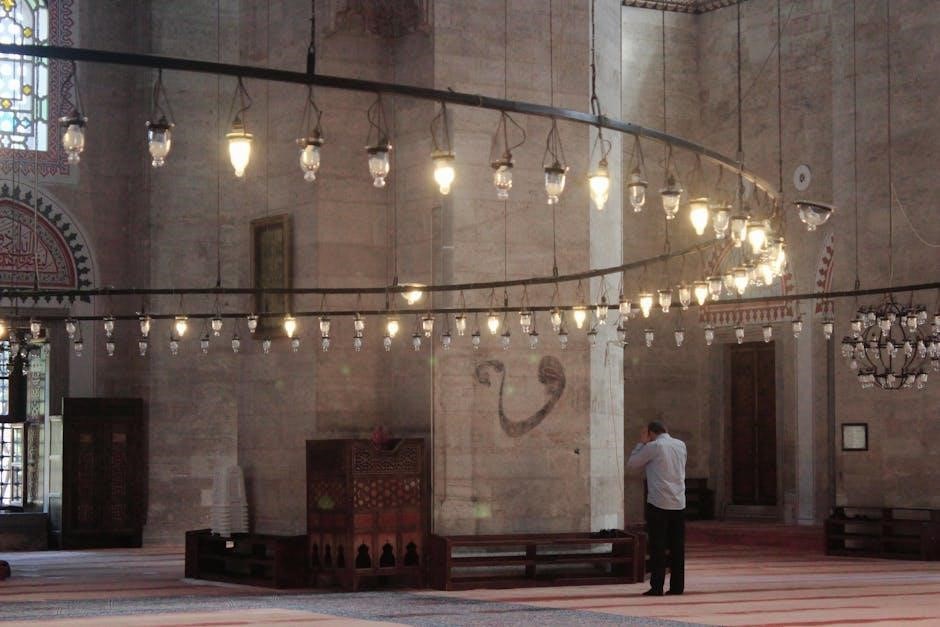
The Tabernacle Prayer Guide offers a structured approach to worship‚ rooted in biblical symbolism‚ helping believers deepen their connection with God through intentional and meaningful prayer practices․
Overview of the Tabernacle Prayer Guide
The Tabernacle Prayer Guide is a biblical model for structured worship‚ drawing inspiration from the ancient Tabernacle described in Exodus․ It provides a step-by-step approach to prayer‚ aligning with the Tabernacle’s layout‚ from the Altar of Burnt Offering to the Holy of Holies․ This guide emphasizes the significance of each component‚ such as the Altar of Incense‚ symbolizing prayer ascending to God‚ and the Table of Showbread‚ representing fellowship with Him․ By following this guide‚ believers can deepen their prayer life‚ fostering intimacy with God and applying biblical principles to modern worship․ It also offers practical applications‚ teaching how to incorporate Tabernacle-based prayer into personal and communal devotion‚ making it a versatile tool for spiritual growth and transformative worship experiences․
Importance of Structured Prayer in Worship
Structured prayer‚ as modeled in the Tabernacle Prayer Guide‚ brings order and intentionality to worship‚ ensuring a deeper connection with God․ By following a biblical framework‚ believers can avoid distractions and focus on meaningful expressions of praise‚ thanksgiving‚ and intercession․ This approach to prayer reflects the sacred design of the Tabernacle‚ where each element symbolized a specific aspect of worship․ Structured prayer also fosters consistency‚ helping individuals and communities maintain a vibrant prayer life․ It provides a clear path for expressing thoughts and emotions‚ aligning with God’s Word and will․ This method not only honors God but also strengthens the believer’s spiritual foundation‚ creating a bridge for intimate communication and transformative encounters with Him․

The Structure of the Tabernacle

The Tabernacle‚ a portable place of worship‚ was intricately designed with specific sections symbolizing God’s presence and humanity’s path to Him‚ reflecting divine order and purpose․
Historical Background of the Tabernacle
The Tabernacle‚ constructed under Moses’ leadership‚ served as the central place of Jewish worship from the wilderness period until King Solomon built the Temple in Jerusalem․ It was a portable structure designed according to divine instructions‚ symbolizing God’s presence among His people․ The Tabernacle’s history is deeply intertwined with the Israelites’ journey‚ providing a sacred space for sacrifices‚ offerings‚ and communal worship․ Its design and rituals were meticulously followed‚ emphasizing holiness and the need for atonement․ This historical context underscores the Tabernacle’s role as a bridge between God and humanity‚ setting the stage for its enduring spiritual significance in prayer and worship practices today․
Layout and Components of the Tabernacle
Layout and Components of the Tabernacle
The Tabernacle was a meticulously designed structure consisting of three main sections: the Outer Court‚ the Holy Place‚ and the Most Holy Place․ The Outer Court contained the Altar of Burnt Offering and the Bronze Laver for purification․ The Holy Place housed the Golden Lampstand‚ the Table of Showbread‚ and the Altar of Incense․ At the heart of the Tabernacle was the Most Holy Place‚ where the Ark of the Covenant resided‚ symbolizing God’s divine presence․ Each component was crafted with specific materials‚ such as gold‚ bronze‚ and fine linen‚ reflecting their sacred purpose․ The layout emphasized a progression toward God’s presence‚ with increasing sanctity in each section‚ underscoring the order and purity required for worship․

Symbolism in the Tabernacle’s Design
The Tabernacle’s design is rich with symbolic meaning‚ reflecting God’s divine plan and humanity’s relationship with Him․ The Outer Court symbolized access to God‚ while the Holy Place represented communion with Him; The Most Holy Place‚ housing the Ark of the Covenant‚ signified God’s throne and divine presence․ The Ark itself‚ with its mercy seat‚ pointed to atonement and forgiveness․ The Golden Lampstand symbolized the light of God’s Word‚ and the Table of Showbread represented fellowship and provision․ The Altar of Incense signified prayer ascending to God‚ while the Bronze Laver emphasized purification․ Each element‚ from materials like gold and bronze to the precise measurements‚ carried deep spiritual significance‚ foreshadowing Christ’s redemptive work and the believer’s journey into God’s presence․
Significance of Each Section in Prayer
The Tabernacle’s structure provides a profound model for prayer‚ guiding believers through a progression of intimacy with God․ The Outer Court‚ with its Altar of Burnt Offering and Bronze Laver‚ symbolizes purification and surrender‚ inviting prayer for cleansing and consecration․ The Holy Place‚ containing the Golden Lampstand‚ Table of Showbread‚ and Altar of Incense‚ represents communion and divine presence‚ encouraging prayers of thanksgiving‚ intercession‚ and worship․ The Most Holy Place‚ housing the Ark of the Covenant‚ signifies the throne of God’s mercy‚ where believers can enter into deep‚ intimate fellowship and prayer for forgiveness and restoration․ Each section serves as a spiritual gateway‚ teaching prayer as a journey from purification to communion and ultimately to union with God‚ reflecting His redemptive plan and the believer’s progression into His presence․
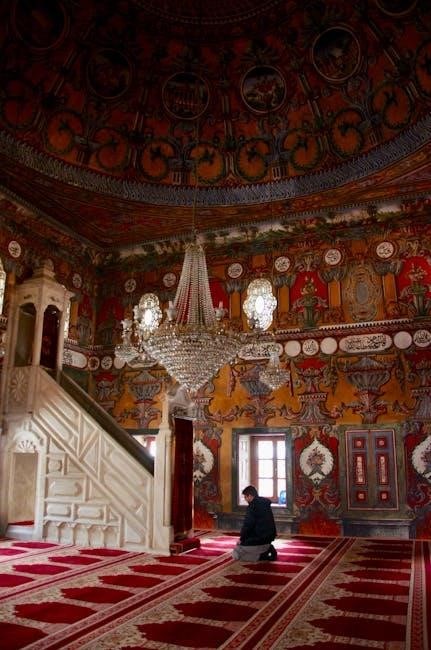
Modern Relevance of Tabernacle Structure
The Tabernacle’s structure remains a timeless guide for modern prayer and worship‚ offering a clear framework for connecting with God․ Its design symbolizes a journey into God’s presence‚ from purification to communion‚ reflecting the believer’s progression in intimacy with Him․ In today’s diverse church settings‚ the Tabernacle model provides a unifying structure for both personal and group prayer‚ helping to organize and deepen worship experiences․ The symbolism of its components continues to inspire contemporary prayer practices‚ bridging ancient traditions with modern expressions of faith․ By aligning prayer with the Tabernacle’s design‚ believers can experience a sense of order and purpose‚ fostering a deeper understanding of God’s presence and redemptive work in their lives․
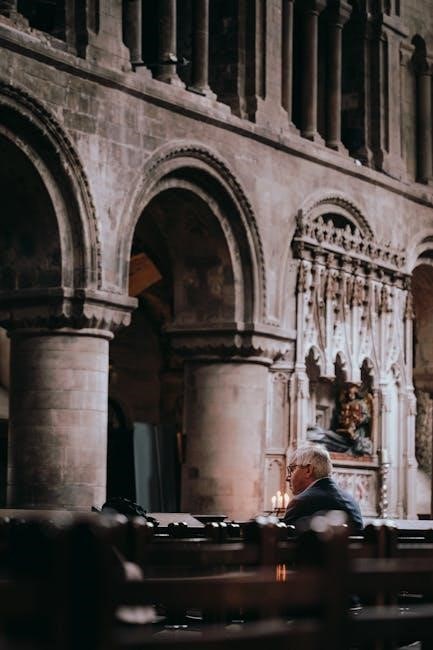
The Significance of Each Component
Each element of the Tabernacle holds profound spiritual meaning‚ guiding believers in structured prayer and worship‚ symbolizing God’s presence and redemptive work‚ and fostering intimate connection with Him․
The Altar of Burnt Offering
The Altar of Burnt Offering symbolizes sacrifice and atonement‚ representing Jesus’ ultimate sacrifice on the cross․ It signifies the believer’s commitment to surrendering their lives to God‚ offering spiritual sacrifices of praise‚ thanksgiving‚ and repentance․ This sacred space reminds us that prayer begins with acknowledging God’s holiness and our need for redemption․ By focusing on the altar‚ we align our prayers with the heart of worship‚ seeking forgiveness and renewal․ It serves as a powerful reminder of God’s mercy and the transformative power of sacrifice in our lives‚ drawing us closer to His presence and purpose․ Through this element‚ the Tabernacle Prayer Guide helps believers establish a foundation of humility and devotion in their prayer life․
The Golden Lampstand
The Golden Lampstand‚ placed in the Holy Place‚ symbolizes the divine light of God’s presence and His Word illuminating believers’ lives․ It represents the Holy Spirit’s role in guiding and enlightening prayer‚ emphasizing the importance of seeking God’s truth and wisdom․ The lampstand’s seven branches‚ often linked to the seven churches in Revelation‚ remind us of the universal call to remain steadfast in faith and to spread God’s light in the world․ In prayer‚ focusing on the Golden Lampstand invites believers to ask for spiritual enlightenment‚ discernment‚ and empowerment to live as light-bearers in darkness․ This element of the Tabernacle Prayer Guide encourages believers to align their prayers with God’s radiant presence‚ fostering a deeper connection and a life transformed by His light․
The Table of Showbread
The Table of Showbread‚ situated in the Holy Place‚ holds profound spiritual significance as a symbol of God’s presence and provision․ The twelve loaves of bread‚ representing the twelve tribes of Israel‚ emphasize unity and God’s faithfulness to His people․ This sacred furniture teaches believers to prayerfully acknowledge God as their sustainer and to seek a deeper communion with Him․ The showbread‚ always present before the Lord‚ reminds us of the importance of continuous prayer and thanksgiving․ In the Tabernacle Prayer Guide‚ focusing on the Table of Showbread invites believers to reflect on their reliance on God‚ express gratitude for His daily bread‚ and pray for spiritual nourishment․ It encourages a posture of humility‚ recognizing God’s abundant provision and seeking to live in His presence with reverence and thankfulness․
The Altar of Incense
The Altar of Incense‚ positioned before the veil in the Holy Place‚ serves as a powerful symbol of prayer and intercession․ Its purpose was to burn incense daily‚ representing the prayers of God’s people ascending to Him․ In the Tabernacle Prayer Guide‚ this altar invites believers to focus on the fragrance of their prayers‚ ensuring they are pleasing and acceptable to God․ The incense‚ made from specific spices‚ signifies the beauty and purity of heartfelt prayer․ As modern worshippers reflect on this altar‚ they are encouraged to pray with intentionality‚ seeking God’s presence and guidance․ The Altar of Incense reminds us that prayer is not merely a ritual but a sacred act of communion‚ where our praises and petitions rise like sweet incense before the throne of grace․
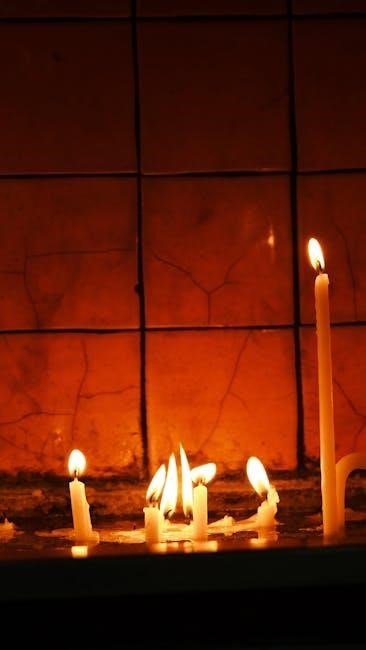
The Ark of the Covenant
The Ark of the Covenant‚ placed in the Most Holy Place‚ symbolizes God’s divine presence and the pinnacle of worship․ Made of pure gold‚ it housed the Ten Commandments‚ Aaron’s rod‚ and a jar of manna‚ representing God’s covenant‚ authority‚ and provision․ In prayer‚ the Ark reminds us of the importance of reverence and trust in God’s mercy․ Its lid‚ the Mercy Seat‚ where atonement was made‚ teaches believers to approach prayer with humility and gratitude for Christ’s sacrifice․ The Ark of the Covenant invites worshippers to seek God’s presence‚ align their hearts with His will‚ and trust in His faithfulness․ It serves as a profound reminder of the holiness of God and the access believers have to Him through prayer․
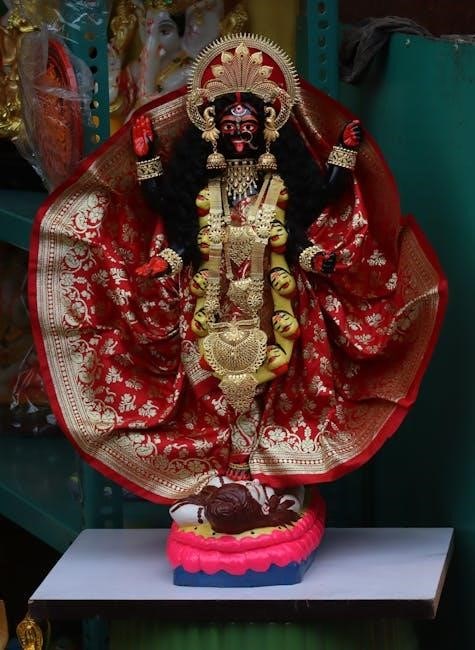
Using the Tabernacle as a Prayer Guide
The Tabernacle Prayer Guide provides a biblical model for structured worship‚ leading believers through a symbolic journey from sacrifice to God’s presence‚ deepening intimacy and reverence in prayer․
Preparing for Tabernacle Prayer
Preparing for Tabernacle Prayer involves setting aside dedicated time for worship and reflection‚ creating a quiet‚ distraction-free space to focus on God’s presence․ Many find it helpful to mentally and spiritually center themselves before beginning‚ often through breath prayers or moments of silence․ Having a prayer guide or Bible nearby can provide structure and inspiration․ Some also light candles or play soft music to enhance the atmosphere‚ symbolizing the sacredness of the moment․ Starting with a brief confession or thanksgiving can align one’s heart with God’s will․ This intentional preparation allows believers to approach prayer with reverence and expectation‚ mirroring the reverence of the ancient tabernacle․
Guided Prayer Through Tabernacle Sections
Guided prayer through the tabernacle sections offers a structured and meaningful way to connect with God‚ reflecting the sacred journey of worship in the biblical tabernacle․ Start by approaching the Altar of Burnt Offering‚ symbolizing surrender and repentance‚ praying for cleansing and forgiveness․ Move to the Golden Lampstand‚ representing God’s presence and wisdom‚ asking for illumination and guidance․ At the Table of Showbread‚ focus on communion and thanksgiving‚ acknowledging God’s provision․ Before the Altar of Incense‚ pray for intercession and spiritual breakthroughs․ Finally‚ enter the Most Holy Place‚ symbolizing intimacy with God‚ where you can express deep adoration and listen for His voice․ This method helps believers experience a profound‚ Spirit-led prayer journey‚ aligning their hearts with God’s divine order and purpose․
Adapting Tabernacle Prayer for Personal Worship
Adapting tabernacle prayer for personal worship allows individuals to create a meaningful and intimate connection with God in their unique spiritual journey․ Begin by setting aside a quiet‚ dedicated space for prayer‚ symbolizing the tabernacle’s sacredness․ Reflect on each tabernacle section‚ such as the Altar of Burnt Offering for surrender or the Golden Lampstand for divine light‚ and tailor your prayers to personal needs or circumstances․ Incorporate journaling to record insights and praises‚ fostering deeper reflection․ Use breath prayers‚ such as “Lord Jesus Christ‚ have mercy on me‚” to maintain a continuous dialogue with God․ This personalized approach enables believers to experience the richness of tabernacle prayer in a way that resonates with their heart and life‚ making worship both authentic and transformative․
Leading Group Prayer with Tabernacle Guide
Leading group prayer using the Tabernacle Prayer Guide fosters unity and depth in corporate worship․ Begin by creating a sacred atmosphere‚ explaining the historical and spiritual significance of the tabernacle․ Guide the group through each section‚ encouraging participants to reflect on personal applications‚ such as surrender at the Altar of Burnt Offering or intercession at the Altar of Incense; Assign roles‚ like reading Scriptures or leading specific prayers‚ to involve everyone․ Incorporate songs or hymns that align with the tabernacle’s symbolism to enhance the experience․ Encourage participants to share testimonies or insights‚ fostering a sense of community․ Conclude with a time of thanksgiving and blessings‚ reinforcing the group’s connection to God․ This structured approach ensures a meaningful and unifying prayer experience‚ drawing believers closer to God and to one another․
Practical Applications
Practical Applications involve creating sacred spaces‚ integrating tabernacle prayer into daily life‚ and teaching others to enhance their worship experience through structured‚ meaningful prayer practices inspired by biblical symbolism․
Creating a Personal Tabernacle Prayer Space
Creating a personal tabernacle prayer space involves setting intentions‚ selecting a quiet location‚ and incorporating symbolic elements like candles‚ prayer journals‚ or biblical imagery․ Begin by designating a specific area for worship‚ free from distractions․ Add elements that inspire focus and connection to God‚ such as a cross or representations of the tabernacle’s components․ Use prayer guides or scriptures to structure your time․ Maintain the space with meaningful objects that reflect your spiritual journey․ This sacred area becomes a refuge for deepening your prayer life‚ fostering intimacy with God‚ and aligning your heart with His presence․ Regularly refresh the space to keep your worship fresh and meaningful‚ ensuring it remains a powerful tool for spiritual growth and communion․
Incorporating Tabernacle Prayer into Daily Life
Incorporating tabernacle prayer into daily life involves making it a consistent habit‚ blending biblical structure with personal devotion․ Start by dedicating specific times for prayer‚ such as morning or evening‚ and use the tabernacle’s components as a guide․ Begin with thanksgiving‚ reflecting on God’s goodness‚ then move to confession‚ seeking cleansing․ Use the altar of incense to intercede for others and the ark of the covenant to worship God’s presence․ Apply the symbolism of the tabernacle to your life‚ such as walking in the light of the golden lampstand or feeding on the Word like the table of showbread․ Keep a prayer journal to track your journey and apply lessons from the tabernacle’s design to your spiritual growth․ This practice helps you stay connected to God‚ finding guidance and strength in everyday life while experiencing transformation through intentional worship․
Teaching Tabernacle Prayer to Others
Teaching tabernacle prayer to others involves sharing its biblical foundation and practical application․ Start by explaining the historical and spiritual significance of the tabernacle‚ using scripture to illustrate its relevance․ Encourage others to adopt structured prayer practices‚ such as using the altar of burnt offering for repentance or the golden lampstand for seeking God’s light․ Provide practical steps‚ like creating a personal prayer space or incorporating tabernacle symbolism into daily devotion․ Share personal testimonies of how tabernacle prayer has transformed your life‚ inspiring others to embrace this method․ Offer workshops‚ small group sessions‚ or one-on-one mentorship to equip others effectively․ Encourage them to teach others as well‚ creating a ripple effect of spiritual growth and deeper connection with God․ This approach fosters community and empowers believers to live out their faith intentionally․
Additional Resources
Discover additional resources such as recommended books‚ websites‚ and online communities dedicated to tabernacle prayer․ Explore workshops and retreats for deeper engagement and learning․

Recommended Reading on Tabernacle Prayer
Enhance your understanding of tabernacle prayer with recommended books like The Tabernacle Prayer Guide‚ which explores biblical symbolism and practical prayer techniques․ Temple Prayer by Lysa TerKeurst offers insights into worship and spiritual growth․ Additionally‚ The Power of Prayer and Biblical Worship provide deeper theological context and historical insights․ These resources are designed to deepen your prayer life and connect you with the rich symbolism of the tabernacle․ Whether for personal study or group discussion‚ these books offer invaluable guidance for those seeking to enrich their worship experience․ They are available in print and digital formats‚ making them accessible for all learners․ Through these readings‚ you can gain a fuller understanding of how to apply tabernacle principles to modern prayer practices․
Online Communities for Tabernacle Prayer
Online communities dedicated to tabernacle prayer provide valuable resources and support for deepening your prayer practice․ Websites like Dreamers Church and Razor Planet Creative Church offer interactive guides‚ video teachings‚ and downloadable materials․ Social media groups on platforms like Facebook and Instagram connect believers worldwide‚ fostering a sense of community and shared spiritual growth․ These forums often feature testimonies‚ guided prayers‚ and insights into the biblical symbolism of the tabernacle․ Additionally‚ online retreats and workshops‚ such as those hosted by Teach Britannica‚ provide structured learning opportunities․ Engaging with these communities can enrich your understanding and application of tabernacle prayer‚ helping you stay connected with others who share your spiritual journey․ They are accessible from anywhere‚ making them a convenient way to grow in faith and prayer․
Workshops and Retreats on Tabernacle Prayer
Workshops and retreats focused on tabernacle prayer offer immersive experiences to deepen your understanding and application of this biblical practice․ Churches like Razor Planet Creative Church host interactive sessions‚ combining teachings on the tabernacle’s symbolism with practical prayer exercises․ Retreats often feature guided meditations‚ group discussions‚ and hands-on activities to explore the spiritual significance of each tabernacle component․ These events provide a dedicated space for believers to reflect‚ worship‚ and grow in their faith․ Many retreats are held in serene locations‚ fostering a tranquil environment for prayer and reflection․ They also offer opportunities to connect with like-minded individuals‚ creating a sense of community and shared purpose․ By attending these workshops and retreats‚ participants can gain a deeper connection to God and a renewed passion for prayer‚ applying the tabernacle model to their daily lives․ These events are invaluable for those seeking spiritual renewal and growth․
The Tabernacle Prayer Guide offers a transformative journey in structured worship‚ equipping believers with profound tools to deepen their spiritual connection and intimacy with God․
Summarizing the Tabernacle Prayer Guide
The Tabernacle Prayer Guide is a biblically rooted framework that uses the structure and symbolism of the Tabernacle to deepen prayer and worship․ By exploring each section‚ believers journey through elements like the Altar of Burnt Offering‚ the Golden Lampstand‚ and the Ark of the Covenant‚ each holding profound spiritual significance․ This guide encourages structured prayer‚ reflection‚ and intimacy with God‚ drawing from the historical and symbolic meanings embedded in the Tabernacle’s design․ It serves as a tool to enhance personal and communal worship‚ fostering a deeper understanding of God’s presence and purpose․ The guide emphasizes the importance of intentional prayer practices‚ aligning modern worship with ancient biblical traditions‚ and provides practical steps for applying Tabernacle principles in daily life․
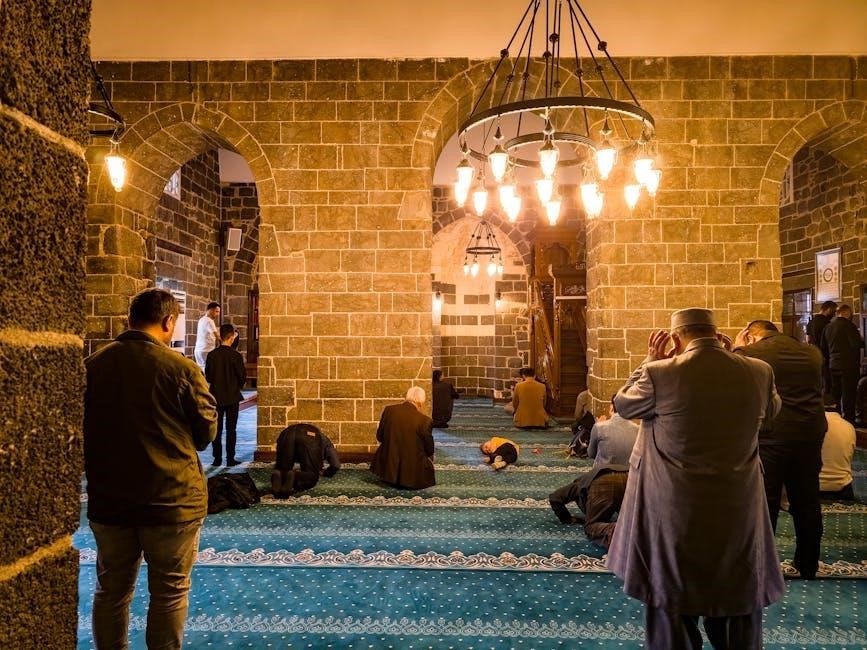
Encouragement for Continuous Prayer Practice
Embrace prayer as a lifelong journey‚ fostering intimacy with God and transforming your spiritual walk․ The Tabernacle Prayer Guide reminds us that prayer is not just a ritual but a powerful tool for seeking guidance‚ strength‚ and peace․ Consistency in prayer deepens our connection to God‚ allowing us to navigate life’s challenges with faith and confidence․ Even when prayers seem unanswered‚ perseverance is key‚ as God works in ways beyond our understanding․ Celebrate small victories and remain steadfast‚ knowing prayer aligns our hearts with His will․ Encourage yourself and others to commit to daily prayer‚ using the Tabernacle as a timeless model․ Let prayer become the foundation of your life‚ drawing you closer to God and empowering you to live purposefully․
Related posts:
Transform your prayer life with our Tabernacle Prayer Guide. Discover powerful insights to deepen your worship and connect with God in a meaningful way.
Posted in Guide